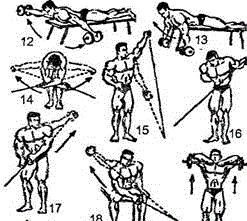
Заглавная страница Избранные статьи Случайная статья Познавательные статьи Новые добавления Обратная связь КАТЕГОРИИ: ТОП 10 на сайте Приготовление дезинфицирующих растворов различной концентрацииТехника нижней прямой подачи мяча. Франко-прусская война (причины и последствия) Организация работы процедурного кабинета Смысловое и механическое запоминание, их место и роль в усвоении знаний Коммуникативные барьеры и пути их преодоления Обработка изделий медицинского назначения многократного применения Образцы текста публицистического стиля Четыре типа изменения баланса Задачи с ответами для Всероссийской олимпиады по праву 
Мы поможем в написании ваших работ! ЗНАЕТЕ ЛИ ВЫ?
Влияние общества на человека
Приготовление дезинфицирующих растворов различной концентрации Практические работы по географии для 6 класса Организация работы процедурного кабинета Изменения в неживой природе осенью Уборка процедурного кабинета Сольфеджио. Все правила по сольфеджио Балочные системы. Определение реакций опор и моментов защемления |
Дайте свою оценку производства продуктов-заменителей на русском и английском языке. ⇐ ПредыдущаяСтр 4 из 4
NOTES 1. food analog – заменитель пищевого продукта 2. to simulate – (зд.) заменять (т.е. копировать) 3. fabricated food – продукт промышленного изготовления 4. marrow – костный мозг 5. to alleviate – облегчать 6. stew – тушеное блюдо 7. casserole – запеканка из риса, овощей и мяса 8. fiber – клетчатка, волокно
Food analogs1 are foods created by humans from agricultural raw materials which possess appearance, flavour, and textural qualities of the foods they are designed to simulate2. They are sometimes referred to as fabricated foods3. Food analogs are fabricated from lower-cost agricultural raw materials such as grains, legumes, by-products of food processing such as cheese whey, fish muscle of little or no economic importance, and meat by-products such as bone marrow4 and low-cost organ meats. Such unlikely sources of protein and other nutrients have been successfully used. There has, therefore, been a great interest of food analogs for two reasons: 1) to supplement human diet since many people cannot afford animal protein in the quantities heretofore consumed, and 2) to supply a palatable source of high-quality nutrients for the people who have never had an adequate supply of nutritive food. There is also a desire for foods designed to alleviate5 certain medical problems, including foods with lower saturated fat, with lower cholesterol, or free of salt or gluten. The concept of food analogs is old in the culinary art. Centuries ago, European homemaker lacking the funds to use much meat learned through the clever use of sauces, flavour, and spices to use lower-cost protein sources such as seafood in soups, stews6, casseroles7, and the like in such a manner that they were acceptable as “meat” dishes. The Oriental people have used hydrolyzed vegetable protein for centuries to impart a meatlike flavour to their food, predominately vegetable and seafood. Soy sauce is an example. Nowadays, advances in science and technology have permitted improvement in this technique since the chemistry of food components is now understood more fully. Food analogs are based fundamentally on a knowledge of the chemistry and technology of protein. Protein is a nutrient of greatest importance in food analogs since it is the nutrient in shortest supply. Because of its physical characteristics, it has become the fiber8, which provides the textural characteristics of the food analog. Using the technology developed for the products of synthetic textile fibers, such as rayon and nylon, a process for preparing synthetic meat from protein fibers has been developed. In the 1950s fifties, a method for producing meatlike analog via a direct extrusion process, eliminating of fibers, was introduced. This method is lower in cost and has enabled the production of analogs with textural characteristics of meat. One more process, known as Lipton process, was actually designed to restructure meats for dry-soup manufacture. Food technologists in contact with scientists continue looking for new methods of creating food analogs. SECTION C Text № 1 «DIGESTION»
Very little natural food can serve as nourishment just as it is, glucose is about the only natural substance that can. While chemists were trying to find what foods are made of, physiologists were trying to learn just what food must be used as nourishment. It soon became evident to the physiologists that foodstuffs must undergo enormous changes in the human body, because the body tissues are profoundly different from the foodstuffs that nourish them. There is very little carbohydrate in the animal body and human fat is not much like either the vegetable fats or milk fat. Certainly the hair, skin and muscles bear little resemblance to the proteins of eggs, milk or wheat.
The word “food” is used loosely to designate anything edible whether it is a natural product such as wheat, fish, or potatoes, a partially processed product such as flour; or cooked foods such as an apple-pie. If it is edible it is food regardless of what must be done to it before it is eaten. Because of this uncertainty of meaning, the nutritionists use the word “food-stuffs” for those portions of the foods the body can use, mainly the carbohydrates, fats and proteins. All digestion is a reaction of the foodstuffs with water or what the chemist calls a hydrolysis. As the digested food passes along the intestines1 it consists of 3 sugars, mostly glucose, about 20 amino acids, glycerol and several fatty acids. There are also salts and some other substances that were in the food, such as acids, chlorophyll, cholesterol and vitamins. Such is the food as it passes through the intenstinal wall into the blood stream to be distributed to the various tissues for growth, repair, or the production of energy.
1- пищеварительный тракт
Text № 2 «CARBOHYDRATES IN OUR LIVES» Carbohydrates commonly occur as starch and sugar. The chief function of starches and sugars in our lives is to produce energy. If we eat them and then if we don’t utilize their potential energy they are stored usually as fat. If ordinary sugar molecules are eaten they are split in two to give the simple sugars, glucose and fructose. Starches end up as glucose. In the body metabolism, fats and carbohydrates play more or less interchangeable roles, but it is generally considered that health is best served if 40% to 50% of the total energy value of the food is in the form of carbohydrates, and 30% to 35% in the form of fats.
Text № 3 «FAT IN THE DIET» Every physiological process in the body requires energy. Energy is needed for the organism to function, to grow and to engage in physical activity, and is stored in food in the form of proteins, fats and carbohydrates. Fat contains twice as much energy as protein or carbohydrate, and is therefore an important source of energy. It also contains the essential polyunsaturated1 fatty acids and is a vehicle2 for the fat-soluble vitamins A.D.E and K. Apart from its nutritional aspects, fat also gives food taste and consistency, and is an excellent vehicle for flavourings. In the body fat provides support and protection for internal organs and provides an important reserve of energy. The body makes its own fatty acids, but only those that are saturated and mono-unsaturated. The essential polyunsaturated fatty acids can be produced only by plants and so have to be supplied via foods. 1 – to saturate – насыщать 2 – vehicle – связующее вещество Text № 4 «PROTEINS AND PROTOPLASM» Proteins represent the stream1 of life. They make up the vital part of that essential jelly material of the living cell – the protoplasm. The beginning of life on this and perhaps a few other planets must have been associated with the formation of proteins. This word means “to take first place”, for there is no life without proteins. If you would like to see proteins, look over your own body, or you can look at one that is practically pure, that is the white of an egg, which is almost all protein or albumen and water. Usually these lost essential of life’s materials have the indefinite and glue-like form known as a colloid though some of them have been separated as pure and definite crystals. Though the detailed2 structures of the molecules are complex, there are only a few chemical elements which enter into their composition. Most proteins contain 51 to 55 per cent carbon, about 7 per cent hydrogen, 20 to 23 per cent oxygen, 15.5 to 18.7 nitrogen, 0.3 to 2.0 per cent sulphur. Some of them also contain a little phosphorus or iron. Nature makes some tremendous structures out of these few materials.
1 – течение, основа 2 – мельчайший
Text № 5 «VITAMINS» Vitamins are organic compounds essential for the normal functioning of the body, and usually obtained from foods. Vitamins are present in minute quantities compared to the other utilizable components of the diet - proteins, fats, carbohydrates, and minerals. Almost all knowledge of the vitamins has been obtained during the 20th century. The discovery of the vitamins has primarily been the result of two lines of investigation: the study of nutritional disease in people and the feeding of purified diets of known composition to experimental animals. In this way vitamin deficiency diseases, known as avitaminoses, have been described. Synthetic and natural vitamins usually have the same biological value. The use of vitamins has been the subject of different research. The principal members of the vitamin groups are A, B, C, D, E, K. The functions of the vitamins are extremely varied and important for health, development and growth.
|
||||||
|
Последнее изменение этой страницы: 2016-08-16; просмотров: 66; Нарушение авторского права страницы; Мы поможем в написании вашей работы! infopedia.su Все материалы представленные на сайте исключительно с целью ознакомления читателями и не преследуют коммерческих целей или нарушение авторских прав. Обратная связь - 3.140.185.170 (0.011 с.) |



